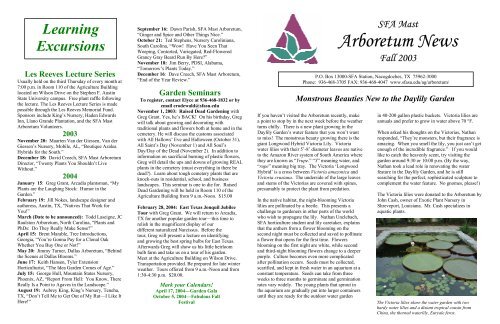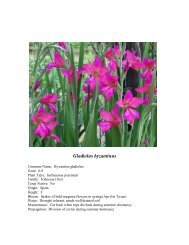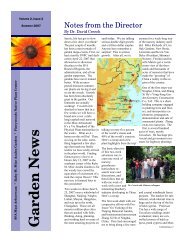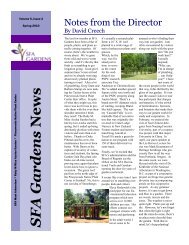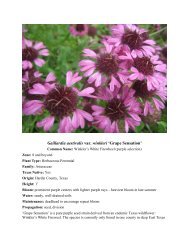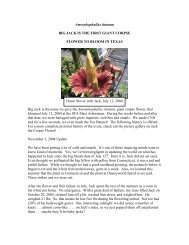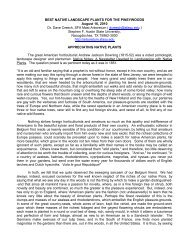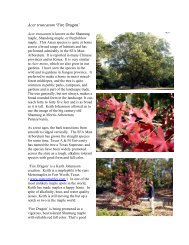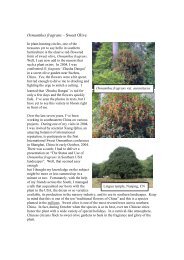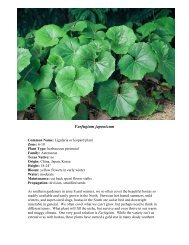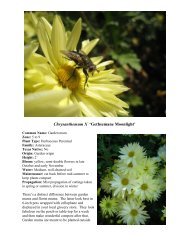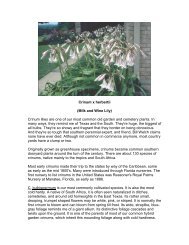Arboretum News - SFA Gardens - Stephen F. Austin State University
Arboretum News - SFA Gardens - Stephen F. Austin State University
Arboretum News - SFA Gardens - Stephen F. Austin State University
Create successful ePaper yourself
Turn your PDF publications into a flip-book with our unique Google optimized e-Paper software.
Learning<br />
Excursions<br />
Les Reeves Lecture Series<br />
Usually held on the third Thursday of every month at<br />
7:00 p.m. in Room 110 of the Agriculture Building<br />
located on Wilson Drive on the <strong>Stephen</strong> F. <strong>Austin</strong><br />
<strong>State</strong> <strong>University</strong> campus. Free plant raffle following<br />
the lecture. The Les Reeves Lecture Series is made<br />
possible through the Les Reeves Memorial Fund.<br />
Sponsors include King’s Nursery, Haden Edwards<br />
Inn, Llano Grande Plantation, and the <strong>SFA</strong> Mast<br />
<strong>Arboretum</strong> Volunteers.<br />
2003<br />
November 20: Maarten Van der Giessen, Van der<br />
Giessen’s Nursery, Mobile, AL, “Boutique Azalea<br />
Hybrids for the South.”<br />
December 18: David Creech, <strong>SFA</strong> Mast <strong>Arboretum</strong><br />
Director, “Twenty Plants You Shouldn’t Live<br />
Without.”<br />
2004<br />
January 15: Greg Grant, Arcadia plantsman, “My<br />
Plants are the Laughing Stock: Humor in the<br />
Garden.”<br />
February 19: Jill Nokes, landscape designer and<br />
authoress, <strong>Austin</strong>, TX, “Natives That Work for<br />
You!”<br />
March (Date to be announced): Todd Laseigne, JC<br />
Raulston <strong>Arboretum</strong>, North Carolina, “Plants and<br />
PhDs: Do They Really Make Sense?”<br />
April 15: Brent Marable, Tree Introductions,<br />
Georgia, “You’re Gonna Pay for a Clonal Oak<br />
Whether You Buy One or Not!”<br />
May 20: Jimmy Turner, Dallas <strong>Arboretum</strong>, “Behind<br />
the Scenes at Dallas Blooms.”<br />
June 17: Keith Hansen, Tyler Extension<br />
Horticulturist, “The Idea Garden Comes of Age.”<br />
July 15: George Hull, Mountain <strong>State</strong>s Nursery,<br />
Phoenix, AZ, “Report From Hell: You Know, There<br />
Really Is a Point to Agaves in the Landscape.”<br />
August 19: Aubrey King, King’s Nursery, Teneha,<br />
TX, “Don’t Tell Me to Get Out of My Rut—I Like It<br />
Here!”<br />
September 16: Dawn Parish, <strong>SFA</strong> Mast <strong>Arboretum</strong>,<br />
“Ginger and Spice and Other Things Nice.”<br />
October 21: Ted <strong>Stephen</strong>s, Nursery Caroliniana,<br />
South Carolina, “Wow! Have You Seen That<br />
Weeping, Contorted, Variegated, Red-Flowered<br />
Grancy Gray Beard Run By Here?”<br />
November 18: Jim Berry, PDSI, Alabama,<br />
“Tomorrow’s Plants Today.”<br />
December 16: Dave Creech, <strong>SFA</strong> Mast <strong>Arboretum</strong>,<br />
“End of the Year Review.”<br />
Garden Seminars<br />
To register, contact Elyce at 936-468-1832 or by<br />
email erodewald@sfasu.edu<br />
November 1, 2003: Raised Dead Gardening with<br />
Greg Grant. Yes, he’s BACK! On his birthday, Greg<br />
will talk about growing and decorating with<br />
traditional plants and flowers both at home and in the<br />
cemetery. He will discuss the customs associated<br />
with All Hallows’ Eve and Halloween (October 31),<br />
All Saint’s Day (November 1) and All Soul’s<br />
Day/Day of the Dead (November 2). In addition to<br />
information on sacrificial burning of plastic flowers,<br />
Greg will detail the ups and downs of growing REAL<br />
plants in the cemetery (must everything in there be<br />
dead?). Learn about tough cemetery plants that are<br />
knock-outs in residential, school, and business<br />
landscapes. This seminar is one to die for. Raised<br />
Dead Gardening will be held in Room 110 of the<br />
Agriculture Building from 9 a.m.-Noon. $15.00<br />
February 28, 2004: East Texas Jonquil Jubilee<br />
Tour with Greg Grant. We will return to Arcadia,<br />
TX for another popular garden tour—this time to<br />
relish in the magnificent display of our<br />
different naturalized Narcissus. Before the<br />
tour, Greg will present a lecture on identifying<br />
and growing the best spring bulbs for East Texas.<br />
Afterwards Greg will show us his little heirloom<br />
bulb farm and take us on a tour of his garden.<br />
Meet at the Agriculture Building on Wilson Drive.<br />
Transportation provided. Be prepared for late winter<br />
weather. Tours offered from 9 a.m.-Noon and from<br />
1:30-4:30 p.m. $20.00.<br />
Mark your Calendars!<br />
April 17, 2004—Garden Gala<br />
October 5, 2004—Fabulous Fall<br />
Festival<br />
If you haven’t visited the <strong>Arboretum</strong> recently, make<br />
a point to stop by in the next week before the weather<br />
turns chilly. There is a new plant growing in the<br />
Daylily Garden’s water feature that you won’t want<br />
to miss! The monstrous beauty growing there is the<br />
giant Longwood Hybrid Victoria Lily. Victoria<br />
water lilies with their 5’-8’ diameter leaves are native<br />
to the Amazon River system of South America where<br />
they are known as “Yrupe.” “Y” meaning water, and<br />
“rupe” meaning big tray. The Victoria ‘Longwood<br />
Hybrid’ is a cross between Victoria amazonica and<br />
Victoria cruziana. The underside of the large leaves<br />
and stems of the Victorias are covered with spines,<br />
presumably to protect the plant from predation.<br />
In the native habitat, the night-blooming Victoria<br />
lilies are pollinated by a beetle. This presents a<br />
challenge to gardeners in other parts of the world<br />
who wish to propagate the lily. Nathan Unclebach,<br />
<strong>SFA</strong> horticulture student and lily caretaker, explains<br />
that the anthers from a flower blooming on the<br />
second night must be collected and saved to pollinate<br />
a flower that opens for the first time. Flowers<br />
blooming on the first night are white, while second<br />
and third-night blooming flowers change to a deeper<br />
purple. Culture becomes even more complicated<br />
after pollination occurs. Seeds must be collected,<br />
scarified, and kept in fresh water in an aquarium at a<br />
constant temperature. Seeds can take from three<br />
weeks to three months to germinate and germination<br />
rates vary widely. The young plants that sprout in<br />
the aquarium are gradually put into larger containers<br />
until they are ready for the outdoor water garden<br />
<strong>SFA</strong> Mast<br />
<strong>Arboretum</strong> <strong>News</strong><br />
Fall 2003<br />
P.O. Box 13000-<strong>SFA</strong> Station, Nacogdoches, TX 75962-3000<br />
Phone: 936-468-3705 FAX: 936-468-4047 www.sfasu.edu/ag/arboretum/<br />
Monstrous Beauties New to the Daylily Garden<br />
in 40-200 gallon plastic buckets. Victoria lilies are<br />
annuals and prefer to grow in water above 70 °F.<br />
When asked his thoughts on the Victorias, Nathan<br />
responded, “They’re monsters, but their fragrance is<br />
amazing. When you smell the lily, you just can’t get<br />
enough of the incredible fragrance.” If you would<br />
like to catch the heavenly scent, try visiting the<br />
garden around 9:30 or 10:00 p.m. (By the way,<br />
Nathan took a lead role in renovating the water<br />
feature in the Daylily Garden, and he is still<br />
searching for the perfect, sophisticated sculpture to<br />
complement the water feature. No gnomes, please!)<br />
The Victoria lilies were donated to the <strong>Arboretum</strong> by<br />
John Cash, owner of Exotic Plant Nursery in<br />
Shreveport, Louisiana. Mr. Cash specializes in<br />
aquatic plants.<br />
The Victoria lilies share the water garden with two<br />
hardy water lilies and a distant tropical cousin from<br />
China, the thorned waterlily, Euryale ferox.
Fern Garden Stumpery<br />
By Roger Hughes<br />
In the early eighteen hundreds in England where<br />
rocks were scarce, stumps were used in gardens in<br />
place of rocks. These were called “Stumperies.”<br />
Stumps were dug in the forest and planted up sidedown<br />
in the gardens. The type, size and shape of the<br />
stumps were considered in the design to create<br />
texture, structure and dimension.<br />
When the Prince of Wales purchased Highgrave<br />
about twenty-five years ago he incorporated a<br />
Stumpery in his garden. He requested that it be<br />
planted with ferns, hellebores and hostas. The tall<br />
plants were placed around the larger stumps and<br />
allowed to grow up through the roots.<br />
In a woodland garden this creates a beautiful<br />
backdrop when the fern fronds intermingle with the<br />
various shades of brown and the rough shape of the<br />
roots. With this in mind we decided to build a<br />
stumpery in the fern garden at the Ruby M. Mize<br />
Azalea Garden.<br />
The new stumpery in the Azalea Garden is on<br />
schedule. The water system and sprinkling heads<br />
have been tested and are ready to go. All of the dirt<br />
work and setting the stumps in place is completed. A<br />
six-inch layer of mulch has been added and worked<br />
into the top layer of soil.<br />
All of the two hundred and fifty plants now planted<br />
in the Stumpery have been donated. Some of the<br />
plants came from as far away as Birmingham,<br />
Alabama. These were donated by Sarah & Ralph<br />
Johnson. Both Sarah and Ralph are very active<br />
volunteers at the Birmingham Botanical Garden.<br />
Besides volunteering, they enjoy growing ferns from<br />
spores. Another very nice donation came from Mary<br />
Elliott in Ponchatoula, Louisiana. Mary is the owner<br />
and operator of Fronderosa, which sells wholesale<br />
landscape ferns and plants for the gulf south. She<br />
has a large collection of ferns plus a big variety of<br />
shade loving plants. Roger and Shirley Hughes<br />
donated the balance of the plants. The following is a<br />
list of the plants that have been planted:<br />
Acer japonicum ‘Giant Leaf’<br />
Adiantum capillus-veneris<br />
Adiantum hispidulum<br />
Adiantum raddianum ‘Fragrans’<br />
Adiantum tenerum ‘Scutum Rose’<br />
Amorphophallus<br />
Amorphophallus<br />
Arisaema triphyllum<br />
Cyrtomium falcatum<br />
Dryopteris erythrosora<br />
Dryopteris kuratae<br />
Dryopteris ludoviciana<br />
Dryopteris namegatae<br />
Dryopteris stewartii<br />
Dryopteris X australis<br />
Galium odoratum<br />
Hosta ‘Blue Angle’<br />
Hosta ‘Blue Cadet’<br />
Hosta ‘So Sweet’<br />
Onoclea sensibilis<br />
Onychium japonicum<br />
Osmunda cinnamomea<br />
Osmunda regalis<br />
Pellaea<br />
Pinellea cordata<br />
Pinellea pedatisecta<br />
Pinellea tripartite<br />
Polystichum polyblepharum<br />
Pteris actinopteroides<br />
Pteris cretica ‘Mayii’<br />
Pteris cretica ‘Rowerii’<br />
Pteris ensiformis ‘Evergemiensis’<br />
Pteris vittata<br />
Saxifraga stolonifera<br />
Selaginella ‘Wordoff’<br />
We are working on creating more shade for the south<br />
edge of the Stumpery. We want to reduce the hot<br />
midday sun. Moving a few plants and planting two<br />
fast-growing trees should solve this problem.<br />
The Hardy Fern Foundation Satellite Garden is doing<br />
very well in its new location. The 2003 shipment of<br />
ferns from the HFF will be shipped October 13.<br />
We will be changing our signage in both the HFF<br />
Satellite Garden and the Stumpery, so we will be<br />
consistent with the Azalea Garden.<br />
Fall Fandango<br />
Picture perfect weather and a full moon graced the<br />
first Fall Fandango honoring 2003 Friends of the<br />
<strong>Arboretum</strong> members. This elegant evening of<br />
delicious food, heavenly jazz, and extraordinary<br />
company was created by a host of volunteers guided<br />
by Carol Moore. Special thanks to Josie Crowson,<br />
Sherrie Randall, Gayla Mize, Mary Louise Jobe, Bill<br />
Jobe, Heinz Gaylord, Rachel Emrick, and, of course<br />
Carol Moore!<br />
Win Day Honeybee<br />
Observation Hive Dedicated<br />
On August 21, 2003, the honeybee observation hive<br />
located in the Mast <strong>Arboretum</strong> was named in<br />
memory of Winthrop “Win” Day. Mr. Day was<br />
instrumental in bringing the hive to <strong>SFA</strong>. He worked<br />
patiently and enthusiastically with <strong>SFA</strong><br />
administrators, contributors from Eastman Chemical<br />
in Longview, and the East Texas Beekeepers to<br />
ensure that the hive would become a reality. Since<br />
the hive’s construction, thousands of children and<br />
adults have been introduced “up close and personal”<br />
to honeybees, their importance as pollinators, and<br />
their fascinating biology and behavior. Over 85<br />
friends, beekeeping colleagues, <strong>Arboretum</strong><br />
volunteers, and family members attended the<br />
dedication, including his wife, Alberta; daughter,<br />
Cynthia Bird; granddaughter, Molly Bird; and greatgranddaughter,<br />
Cheyenne Watson. Marcie Nelson<br />
presented a plaque to Dr. David Creech with a<br />
photograph of Win in his beekeeper’s suit and the<br />
inscription: In Memory of Winthrop “Win” Day<br />
beloved Husband, Father, Grandfather, and Friend<br />
dedicated to the art of apiary education for children<br />
and adults and the love and appreciation of bees. His<br />
gentle spirit and kindness will be remembered.<br />
Win Day shared his time<br />
and enthusiasm for bees<br />
and beekeeping freely with<br />
staff, students, volunteers,<br />
and thousands of school<br />
children who visited the<br />
<strong>SFA</strong> Mast <strong>Arboretum</strong>.<br />
<strong>SFA</strong> Completes Universally<br />
Accessible Trail<br />
Thousands of azalea blooms, Japanese maples, and<br />
other spring ornamentals attract hundreds of visitors<br />
each spring to the Ruby M. Mize Azalea Garden.<br />
Garden officials are hoping that that recently<br />
improved trails will attract even more visitors.<br />
The trails now meet Americans with Disability Act<br />
standards through a joint effort by <strong>SFA</strong> Disability<br />
Services, the Physical Plant, and the <strong>SFA</strong> Mast<br />
<strong>Arboretum</strong> to pave a 5-foot-wide path of asphalt<br />
along the entire 1.25 mile trail network.<br />
In addition to making navigation of the trails easier<br />
for visitors with physical challenges, the garden is<br />
more user-friendly for bikers, joggers, walkers, and<br />
families with children in strollers.<br />
“What I like about this project is that it is a vast<br />
improvement for everybody, not just those with<br />
special needs,” said Michael Stevenson, chairman of<br />
the Nacogdoches Mayor’s Committee for People<br />
with Disabilities.<br />
A new parking area located at the west side of the<br />
garden is marked for handicapped parking and<br />
unloading. One-way access to this parking area is by<br />
way of the road down the middle of the garden,<br />
named “Axes Promenade.”<br />
“Now the garden is ready for all visitors,” said Dr.<br />
David Creech, Mast <strong>Arboretum</strong> director, “just in time<br />
for camellia season which begins in October!”<br />
Special thanks to our 2003<br />
Fall Fandango Sponsors!<br />
Doremus Nursery, Warren<br />
Earth and Stone, Lufkin<br />
David Kolb Excavating, Nacogdoches<br />
Trees USA, Lindale<br />
East Texas Pinestraw, Lufkin


